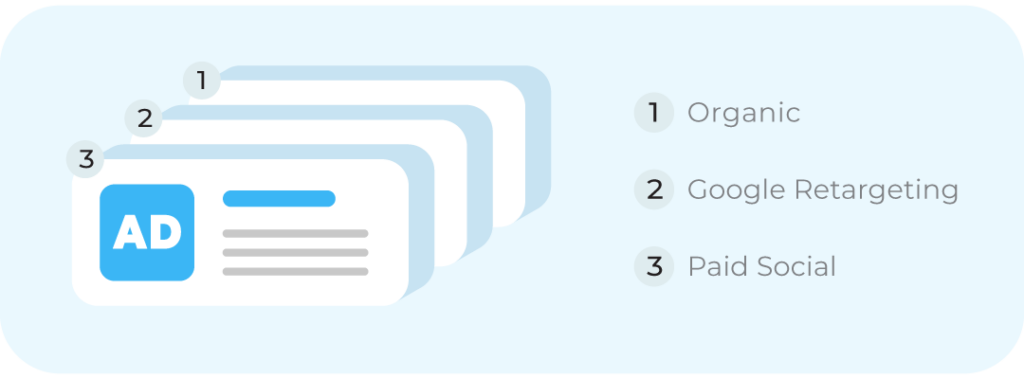3 Multi Touch Attribution Models
Today’s buyer’s journey is full of multiple touchpoints. From paid ads on Google and Bing to social ads and website pages, organizations are connecting with prospects in many places. Knowing which of these touchpoints drives the most leads–and conversions–is information marketers can’t do without. With multi touch attribution, you know how each of your channels, ads, and keywords are performing so you’ll know precisely where to focus ad spend–and where to pull back.
According to a Forrester report, B2B buyers engage in about 27 interactions before a conversion. As economic uncertainty continues, marketers must have this data on key interaction points so they can optimize the right campaigns and maximize their budgets. Multi touch attribution unlocks much of this data and gives marketers the information they need to thrive–even during times of economic challenges.
What is Multi Touch Attribution?

Multi touch attribution is a type of marketing attribution that provides data about more than just one touchpoint in the customer journey. Traditional attribution models like first and last touch models give credit to only one touchpoint. However, as the name indicates, multi touch attribution tracks and attributes numerous touchpoints in the customer’s journey. Depending on which type of multi touch attribution model you use, credit is distributed differently amongst each of the touchpoints.
Today’s customer journey is rarely linear. Often, customers and prospects interact with your brand in one place, then come back a week or two later on a different channel only to go cold for a few weeks and then visit your website. Research indicates that there are an average of eight touchpoints that occur before a conversion.
Multi touch attribution gives you insight into each of the customer touchpoints. This is helpful in several ways:
- Maximize ad spend and marketing efforts in the right area
- Align sales and marketing teams
- Provide exceptional customer experiences
- Shorten the sales cycle
- Fine-tune messages to drive conversions
There are different types of marketing attribution models. Classic models include first and last touch marketing attribution models. As mentioned, these models give 100% credit to either the first touchpoint the customer visited or, as the name indicates, the last touchpoint before the conversion.
Other types of multi touch attribution take into account several touchpoints in the customer’s journey. It’s important to understand each model so you can figure out which one is best for your organization and current marketing goals.
You’ll also want to understand a bit about each of the models because you may want to use one type of attribution model in one situation, and a different model when measuring different criteria. Let’s explore three multi touch attribution models:
3 Types of Multi Touch Attribution Models
Multi touch attribution models help marketers determine which of their ads, campaigns, and even keywords are performing the best, which aren’t doing so well–and everything in between. What differentiates most of these models from one another is how much weight or credit it gives to the different touchpoints.
- Linear model
The most basic of the multi touch attribution models is the linear model. It tracks the touchpoints from first to last and each in between giving equal ‘credit’ to each touchpoint.
For example, if your customer first visited your website, then two days later clicked an ad on Facebook, the next day went back to your website, and a week later clicked on a Google Ad which led to the purchase of your product or service, each one of those touchpoints would get equal credit for the conversion.
This type of attribution model is good for those just getting started with attribution and tracking or starting up a new, smaller-sized business.
- Time decay model
This model again tracks all the touchpoints on the buyer’s journey but gives more credit or weight to the touchpoints closer to the conversion. The time decay model may be a good choice for B2B organizations that frequently have long sales cycles.
- Position models
These models include U-shaped, W-shaped, and Z-shaped, with more customized models continuing to emerge. With these multi touch models, each of the touchpoints is given different amounts of credit based on the specific model.
For the U and W-shaped models, equal credit (40% and 30% respectively) is given to the first and last touchpoints with the remaining amount divided evenly between the touchpoints.
In the Z-shaped model, credit is given to first touch, last touch, marketing-qualified lead, and sales-qualified lead points. Credit is divided evenly amongst these touchpoints with a remaining percentage divided between other touchpoints if they exist.
When to Use Each Model
The variety of multi touch attribution models lets marketers choose different models for measuring various marketing goals. When it comes to attribution models, you don’t have to stick to one model. It’s important to choose different models to measure evolving goals. One model may be good to measure one area and another type to measure something different.
The marketing attribution model you choose depends on what exactly you are trying to measure. If you are looking for a general overview of where your customers are clicking and really just getting started with attribution, then the linear model may work.
If you are looking for information about what type of ads and campaigns close the highest-value conversions, you may want to choose a time-decay model that focuses on the touchpoints closest to the conversion.
On the other hand, if you want to see what’s working to attract customers, a position-based model may be for you. With some multi touch attribution models, you can customize how much credit is given to each of the touchpoints. Being able to do this will let you focus on strategic goals and analysis.
Tracking and Attributing Offline Interactions

It’s important to understand that each of these models, as well as first-touch and last-touch models, will track and attribute online activity only. Activity from Google Ads, website visits, social platforms, and more. However, when your visitor goes offline and picks up the phone you will most likely lose their trail. If this call leads to a conversion, it may be attributed to an incorrect source skewing your data. Knowing each of these touchpoints is vital–and often obscured from marketers.
When you don’t have accurate data and the trail goes cold when a prospect picks up the phone, you could be making marketing decisions based on misinformation. This can lead to issues in budgeting and decision-making. Knowing–and proving–your true ROI on all of your marketing efforts is key to success–and job security!
Discover more ways to optimize ROI in our guide, Uncovering Hidden Ad Revenue without Increasing Spend
Using a call tracking platform with dynamic number insertion (DNI) you can connect phone calls to any online activity your customer has. For example, if your potential customer sees a Google Ad and clicks on it one day, then a week later clicks on a different ad, then they call you from a number on a landing page, you’ll know each of the steps they took before picking up the phone. Call tracking also gives you more information about your caller so agents can personalize the call and automate follow-up actions. Follow-up automation includes:
- Automatic callbacks
- Text follow-ups
- Incoming calls routed to best-suited agent
- Lead and call scoring
- Lead and call tagging
Marketers who use multi touch attribution models are able to take a look at how their prospects and customers are interacting with each touchpoint. This is vital, especially in times of economic uncertainty, so you can maximize your marketing budget by focusing on what’s driving the most conversions. Using attribution to make smarter decisions, ones that are backed by comprehensive data, will help your organization succeed–no matter how the economy is doing.
In addition, when you use attribution in conjunction with call tracking, you’ll empower your sales and marketing teams with more information about your prospect so they can personalize conversations they’re having.
Sales teams and agents will know more about the caller as soon as the line rings, and marketers will know what keywords, graphics, messaging, and ad channels are resonating most effectively. This lets teams create exceptional customer experiences to keep customers and create raving fans of your company. Teams save resources and are able to do more with the information gained from attribution.
Summary
Today’s competitive landscape means marketers have to be savvy about what tools they’re using and how they’re tracking and attributing both online and offline activities. Using multi touch attribution models along with a platform that lets you track offline activity is essential to compete.
If you want to learn more about the benefits of using call tracking along with attribution, check out a few of our Case Studies. You’ll also see how we’ve helped other organizations consistently drive revenue and prove ROI. If you want to see our platform in action, Book a Demo!
